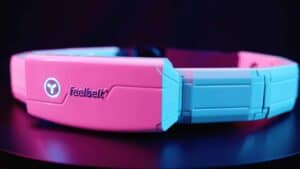Expanding the range of sensations is essential to the development of virtual reality. A new haptic feedback belt from the German company Feelbelt is an innovative solution to the technical challenges. Unlike complex gloves or bulky haptic vests, Feelbelt is simply strapped around your waist and plugged into your audio source. It can be used for VR apps and games, or just for a more immersive experience of music or traditional media like movies.
While there’s fascinating research underway on future haptic solutions such as an ultrathin wearable skin, we find most of the current vest-style solutions frustrating. We love what they do, but find them difficult to put on. They also won’t move much beyond the gaming community.
Simple to use Haptic Feedback Belt
On first take, this has to be one of the most ingenious solutions to expanding our sense of immersion. It’s easy to set up, comfortable to wear – as foolproof as the Oculus Quest. The belt provides around six hours of feedback on a charge (through a USB C port) and plugs into any standard audio port. According to VRScout,
Worn like a traditional belt, feelbelt looks like something you might see in a sci-fi film. The device uses 10 impulse generators each capable of transmitting frequency spectrums in different patterns or all at once in multiple directions. Put simply, the belt allows you to “feel” sounds via detailed vibrations. An explosion on your left, for example, will cause the left side of the feelbelt to rumble harder than the right side and vice-versa.
Combined with the haptics in your controllers, the feelbelt promises more cavernous and emotional VR experience that engage all of your physical senses. No doubt the device would pair well with titles such as WaveXR, Audiotrip, Beat Saber, and Pistol Whip.
And yes, we could see it with Half-Life: Alyx, one of the most immersive VR games on the market.
The Clear Advantages of a Belt
Obviously, a haptic feedback belt will not provide the full range of sensations you find in a vest. But it solves a challenge most other companies in the feed ignore – making a wearable device that fits women and different body types. If you’ve watched someone try to demo a haptic vest at a VR conference, you know what we’re talking about. It checks off all the requirements for a simple haptic solution in a VR lab or workshop.
Importantly, Feelbelt’s device could also address some of the accessibility challenges in VR by providing sensations for the hearing impaired. That you can dial in the range of feedback on an app on your phone opens a range of possibilities.
Feelbelt’s haptic feedback belt is already fully funded on Kickstarter and should be available in September 2020. The device will cost 199 Euros / $222 U.S., and we’ll follow up with additional information as soon as we get one.
Emory Craig is a writer, speaker, and consultant specializing in virtual reality (VR) and artificial intelligence (AI) with a rich background in art, new media, and higher education. A sought-after speaker at international conferences, he shares his unique insights on innovation and collaborates with universities, nonprofits, businesses, and international organizations to develop transformative initiatives in XR, AI, and digital ethics. Passionate about harnessing the potential of cutting-edge technologies, he explores the ethical ramifications of blending the real with the virtual, sparking meaningful conversations about the future of human experience in an increasingly interconnected world.

